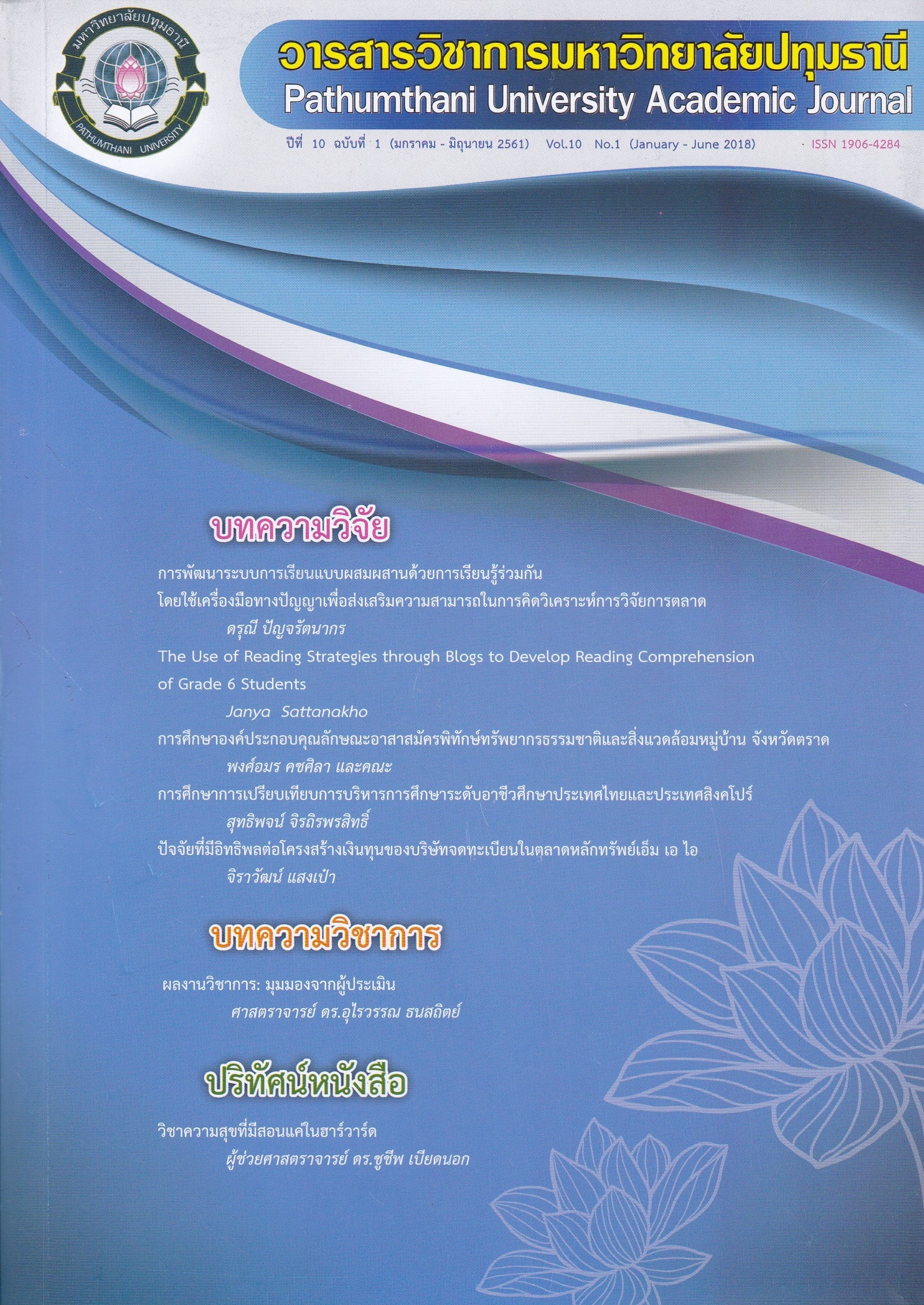Develop a blended learning system using collaborative learning and cognitive tools to enhance an analytical thinking abilities in marketing research for undergraduate students
Keywords:
การเรียนแบบผสมผสาน, การเรียนรู้ร่วมกัน, การคิดวิเคราะห์Abstract
The purpose of this research was to develop a blended learning system using collaborative learning and cognitive tools to enhance an analytical thinking abilities in marketing research for undergraduate students. The research and development (R&D) procedure were divided into two phases: 1) created the blended learning system using collaborative learning and cognitive tools to enhance an analytical thinking abilities in marketing research for undergraduate students (Collab & CTBL System), and 2) study the effect of using a Collab & CTBL System. The sample group in this study consisted of 20 undergraduate students at the Faculty of Business Administration, Rajapruk University who had enrolled to the Marketing Research in the first semester of 2016. The experiment period was 14 weeks. The instruments used in this research consist of the Learning Management System (LMS), analytical thinking abilities evaluation forms, collaborative learning and cognitive tools that reflect to analytical thinking abilities evaluation forms, marketing research report evaluation forms, and opinion questionnaires. The quantitative statistics used in this study are frequency distributions, percentage, mean, standard deviation, and t-test Dependent. The results of this research were as follows: 1. The Collab & CTBL System consisted of four main components as followed: 1) input consisted of six subcomponents: [1.1) instructor, 1.2) learner, 1.3) content, 1.4) learning management method, 1.5) learning media, and 1.6) evaluation)], 2) process, 3) output, and 4) feedback. The learning process consisted of 3 processes: 1) preparation, 2) setting the learning activities, and 3) evaluation. The instructional process consisted of five steps: 1) offer subject to study and grouping students, 2) meeting planning and creating agreement, 3) construction project or piece of work consisted of five steps: [3.1) specify their requirements analysis, 3.2) define the problem or objective associated with the requirements analysis, 3.3) specify principles or rules to separate the components of the their set, 3.4) classification criteria, and 3.5) debate and conclude the solutions within the group,] 4) presentation of the project, and 5) discussion and summary 2. The undergraduate students learned with the Collab & CTBL System had a statistically significant difference of the analytical thinking abilities posttest scores higher than pretest scores at .05 level. The students agree that the Collab & CTBL System was appropriate in a high level.
References
2. ปณิตา วรรณพิรุณ และ วีระ สุภะ. (2555). รูปแบบการเรียนรู้ร่วมกันผ่านสื่อสังคมออนไลน์เพื่อสนับสนุนการเรียนด้วยโครงงานนิเทศศาสตร์สาหรับนักศึกษาระดับบัณฑิตศึกษา. [ออนไลน์ ]. เข้าถึงเมื่อ 30 มีนาคม 2555, จาก http://www.slideshare.net/drpanita/nec2012-panita-wera-ppt
3. ประพรรธน์ พละชีวะ . (2550). การนำเสนอรูปแบบการเรียนแบบผสมผสานด้วยการเรียนรู้ ร่วมกันในโครงการวิทยาศาสตร์สำหรับการฝึกแก้ปัญหาของนักเรียนชั้นมัธยมศึกษา ปีที่ 1. วิทยานิพนธ์ครุศาสตรดุษฎีบัณฑิต จฬุาลงกรณ์มหาวิทยาลัย.
4. พันธ์ศักดิ์ พลสารัมย์. (2558). การปฏิรูปการเรียนการสอนระดับอุดมศึกษา. [ออนไลน์]. เข้าถึงเมื่อ 8 พฤศจิกายน 2558, จาก http://www.edu.chula.ac.th/eduinfo/ed_resch/pansak.pdf พิริยกานต์ วงศป์ระสิทธิ์. (2555). การพัฒนากรอบการท างานส าหรับการแนะน าวิธีการ แก้ปัญหาในรูปของโปรแกรมประยุกต์บนเว็บโดยใช้แผนความคิด. [ออนไลน์]. เข้าถึง เมื่อ 8 เมษายน 2558, จาก http://tdc. thailis.or.th
5. วิวรรธน์ จันทร์เทพย์. (2553). การพัฒนารูปแบบการเรียนรู้แบบผสมผสานด้วยการเรียนรู้ร่วมกันเป็นทีม เพื่อพัฒนาทักษะการคิดวิเคราะห์. วิจัยสถาบัน. มหาวิทยาลัยราชภัฏจอมบึง.
6. สำนักงานคณะกรรมการการศึกษาแห่งชาติ. (2542). พระราชบัญญัติการศึกษาแห่งชาติ พ.ศ. 2542 แก้ไขเพิ่มเติม (ฉบับที่ 2) พ.ศ. 2545. กรุงเทพมหานคร: พริกหวานกราฟฟิก.
7. ไสว ฟักขาว. (2542). การจัดการเรียนการสอนที่เน้นผู้เรียนเป็นศูนย์กลาง. กรุงเทพฯ: เอมพันธ์.
8. Johnson, D.W. and Johnson, E.P. (1986). “Action research: Cooperative learning in the science classroom”. Science and Children. 24: 31-32
Downloads
Published
How to Cite
Issue
Section
License
บทความที่ได้รับการตีพิมพ์เป็นลิขสิทธิ์ของวารสารมหาวิทยาลัยปทุมธานี
ข้อความที่ปรากฎในบทความแต่ละเรื่อง เป็นความคิดเห็นส่วนตัวของผู้เขียน กองบรรณาธิการไม่จำเป็นต้องเห็นด้วยเสมอไป และไม่มีส่วนรับผิดชอบใด ๆ ถือเป็นความรับผิดชอบของผู้เขียนแต่เพียงผู้เดียว



